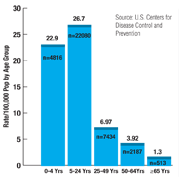 Q: There’s been a lot of talk about swine flu. Really, how widespread will the swine flu be this fall?
Q: There’s been a lot of talk about swine flu. Really, how widespread will the swine flu be this fall?
A: “Predictions are that it will be fairly widespread, based on the experience right now in the Southern Hemisphere,” says Robert C. Kalayjian, M.D., director of the Infectious Disease Division at MetroHealth Medical Center, in Cleveland.
Because the Southern Hemi-sphere is ending its winter season now, authorities in the Northern Hemisphere have been watching the virus’s pattern below the equator to predict its spread for this winter up here. “In the Southern Hemisphere, they’re experiencing widespread infection, and the H1N1 flu occurred earlier in the flu season than typical seasonal influenza,” Dr. Kalayjian says. “So, we’ll have similar or higher rates in the Northern Hemisphere during our winter months, and likely an earlier start as well.”
 |
| Unlike seasonal flu, most cases of swine
flu have been in people under age 24.
Source: U.S. Centers for Disease Control and Prevention |
Specifically, the number of deaths related to H1N1 flu has been highest among people 25 to 49 years old (39%), followed by people 50 to 64 years old (25%) and people five to 24 years old (16%), according to the U.S. Centers for Disease Control and Prevention (CDC). By comparison, an estimated 90% of deaths due to seasonal flu occur in people age 65 and older. Overall, the CDC reported 8,843 hospitalized cases and 556 deaths in the U.S. from the H1N1 flu as of late August. Worldwide, the World Health Organization (WHO) reported more than 209,438 laboratory-confirmed cases of H1N1 influenza and 2,185 deaths.
How can doctors of optometry recognize the signs and symptoms of the H1N1 virus in patients, and what precautions can be taken to prevent it from spreading? The symptoms of swine flu and seasonal flu are generally the same—the key feature is febrile respiratory illness. Flu viruses spread mainly from person to person through coughing or sneezing. Infection also occurs when touching objects or surfaces with flu viruses on them and then touching the mouth or nose. “As an optometrist, you have close contact with patients,” Dr. Kalayjian says. “So, if patients have fever in association with respiratory symptoms—which include cough, runny or stuffy nose, shortness of breath or sore throat—as well as chills, fatigue or headaches, then they should probably defer eye evaluations until they’re checked out by their family doctors.” The same goes for you and your staff, he says. Anyone with these symptoms should stay home for at least 24 hours after the fever is gone.
Other general precautions:
• Wash hands frequently, or use alcohol-based hand sanitizer.
• Use gloves if you are likely to come in contact with the patient’s eye or tears.
• Cover your mouth and nose when coughing or sneezing.
• Avoid touching your eyes, nose and mouth.
• Avoid close contact (less than six feet) with people who have flu-like symptoms.
• Set up a plan in case a significant number of your staff is absent from work.
• Provide hand sanitizer in waiting areas and examination rooms; offer surgical masks to symptomatic patients; and provide facial tissues and receptacles for their disposal.

